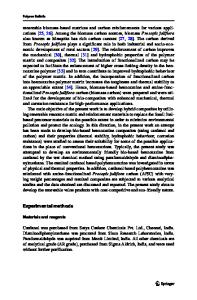Characterization of novel composites from polybenzoxazine and granite powder
- PDF / 2,795,458 Bytes
- 9 Pages / 595.276 x 790.866 pts Page_size
- 55 Downloads / 425 Views
Characterization of novel composites from polybenzoxazine and granite powder Ravi Krishna Swami Garigipati1 · Ramakrishna Malkapuram1 Received: 2 April 2020 / Accepted: 12 August 2020 © Springer Nature Switzerland AG 2020
Abstract The potential of using granite dust as reinforcement into polybenzoxazine matrix was investigated. In this article, novel granite powder waste-reinforced bisphenol-A aniline-based benzoxazine composites were prepared using solution blending technique by varying the content of granite powder from 10 to 40 wt%. The effect of the granite powder content on the thermal, structural, dimensional, and morphological properties of granite powder/polybenzoxazine composites have been investigated. Thermogravimetric analysis (TGA) was performed on the composite samples. Char yield of the composites increased from 44.55 to 67.70% for increasing filler content from 10 to 40wt%, whereas 22% for pure polybenzoxazine. The maximum weight loss temperatures of the composites were analyzed from derivative of thermogravimetric analysis (DTG). Limiting oxygen index (LOI) values also increased as granite powder content increased. Structural properties of benzoxazine, polybenzoxazine, and composites were observed with Fourier-transform infrared spectroscopy (FTIR). Dimensional stability of the composites was investigated through the water absorption test up to 30 days. The composites exhibited zero percent water absorption. Micro-hardness of the composites increased from 17.45 to 78.66% for increasing filler content from 10–40 wt% when compared with pristine polybenzoxazine. The morphological analysis using scanning electron microscopy (SEM) showed the distribution of filler, aggregate formation, compatibility between polybenzoxazine and granite powder. Overall, the importance of using granite powder waste as reinforcement in polybenzoxazine composites revealed from results of the structural, dimensional, and morphological analysis along with the improvement in thermal properties and micro-hardness. Keywords Granite powder · Polybenzoxazine · Composite · Thermal · Structural · Micro-hardness · Morphology · Water absorption
1 Introduction A million tonnes of stone production take place throughout the world every year, which causes the generation of massive waste. Granite slurry waste is a product obtained while shaping granite rocks. This is mainly composed of quartz, small content of mica, feldspar, amphiboles, and other elements [1]. The importance of the work is to utilize granite stone waste which is anti-biodegradable and causing various problems if it mixes into the air or when it is
left on the ground. Currently, industrial waste-reinforced polymer composites are gaining researchers and industrialist’s attention [1–3]. Yet little research done on the use of waste granite powder as the filler in thermosets has been published so far. Pawar M.J. et al. reported about granite powder, jute fiber, and carbon fiber, granite powder-reinforced epoxy composites [4, 5]. Shujit et al. presented in a paper about po
Data Loading...











